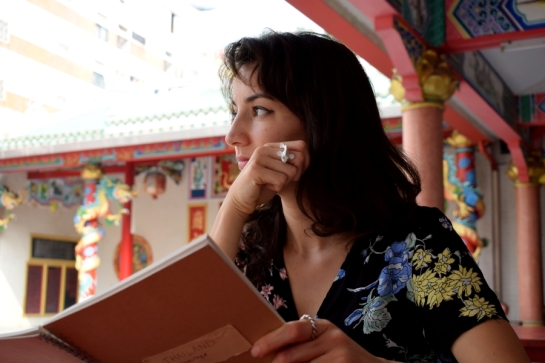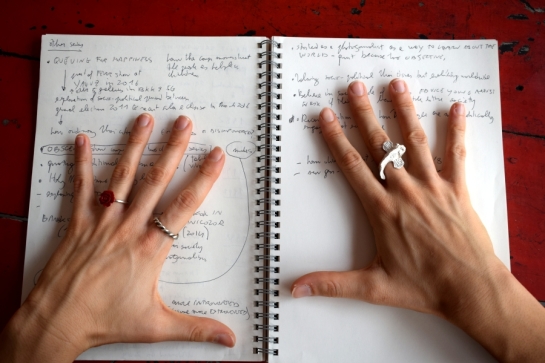My writing, lately

It’s a long time I don’t press pause from the journalistic mode for a moment, to share some parts of my life as an arts and culture writer. I decided to do it today, to spell out the cardinal points that drive my writing today. Spelling them out for myself in the first place, of course, so I can embrace them with more awareness.
I must start by saying that, as writers, we might take our work lightly, but holding a pen is like holding a sword (or a bo staff to pick my weapon of choice.) That’s why I have decided to always make my best to be impeccable with my words, using this power for good. Some of these ethics I took to balance out my original spirit, which is quite combative, in a way which gives me strength and passion, but can easily get out of hand.
Service
I have a sticker with a quote on my computer. It’s a spiritual signpost from a Marianne Williamson’s talk. What is says applies to basically any kind of work, but particularly to writing. It’s explains why I don’t like clear-cut critique, and I strive to consider all points of view, before start criticizing. It’s: “With out work we are soughing to bring harmony, light and understanding to the field we are assigned to – and we are not alone. We are all at the service of the healing of the world.”
I have been told in the past I am too “soft” in my writing. That art critique is supposed to be much harsher, and my attitude is too “motherly.” That I should be tougher. Some assumed I take this attitude because I don’t want to make enemies in such a small art world as the Southeast Asian scene – implying that in order to make a good job you must make enemies. The truth guiding my life is that enemies are not of use: “You have very little morally persuasive power with people who can feel your underlying contempt.” This what Martin Luther King said.
I believe we have already so much polarity in the world. I have things that enrage me of course, and I have an hard time just like anyone else being compassionate towards things like bullism, sexism, injustice. But even then, through the filtered, more reasoned medium of my writing I can take a step back and not attack the person. I can rather explain why this attitude is hurtful, and fight the system that produced it.
One more word on harsh criticism. I can’t ignore the context I’m working in. I’m in a position of privilege as an Italian writing of Southeast Asia and Middle East. Europe has colonial responsibilities, and I’m continuously trying to avoid the orientalist stare. There are some things that’s just unfair to say to artists, people and populations who have suffered. This is basic empathy, and honestly I’m not eager to let it go. I sure have steered away from this in the past. But I’m recommitting to this every single day.
For my writing, I won’t settle for anything less than harmony, light, joy, interestingness and understanding. And the truth I feel in my bones.

Slay the patriarchy
… but of course you know me and you know I’d slay the patriarchy any day of the week. Striving to be guided by compassion and love, rather that anger which – I admit – regarding this topics often gets the best of me.
There is a thing that differentiate the work I do in my graphic novels and in my writing. Art is about Dyonisus, it’s raw material, you can’t give a social rule to it. It’s instinct and desire. On the other hand the writing is Apollo, it’s what gives a shape to the instinct and it’s ruled by ethics. It what allows humans to live in harmony and what educates our worse instincts.
I agree with writer Elena Ferrante who in “La Frantumaglia”, when asked about her favourite writers, intentionally mentions only women. She points out that the long-muted tradition of women writers needs to be still solidified and recognized my male writers also. We are still waiting for the majority of men writers – and this goes also for the arts – to look at women writers seriously, as a reference for themselves, without any sense that he’s doing our gender a favor.
In my first researches in the emerging art systems I didn’t pay so much attention to gender balance – also because artists in SEA and Middle East are overwhelmingly male and women tend to not promote themselves as much. I have found many female curators and gallerists, and that appeased me. Today that’s not enough. Just like the former colonial countries are striving to build their own art history, taking from the west but conveying their own values, this goes also for women’s narratives.
In many fields both our pain and our responses are coming out. We are not united in this, there are still some who are nostalgic of “defined gender roles” and those who will dismiss “women art” as a sub-category. And the worse, those who calls us “boring” or “rhetorical” is we defend our ideas or individuality or our right to speak for ourselves as women. Living in Italy, a country which has a deep-seated tradition of silencing women, even using the term “patriarchy” makes me sometimes feel uncomfortable – and that’s precisely why I should start using it more.
There is a enormous potential which has not been yet unleashed in women’s art making. A type of art made on our own terms. So what I’m doing in my writing again is leaving more and more room to women artist, but without creating a sub-category for them, as I have certainly done in the past. It’s artists, and that’s it.
Beyond the western narrative
The same methodology also goes for artists from what are in the west called “the new geographies,” namely what I’m usually work on. I’m aware of the privilege of living in the Western world, and I’m interested of learning what artists from the East can teach me about humanity, art drawn from my direct experience, and a different conception that art can have in society.
There is nothing more hideous that a paternalistic stare, or even worse, wanting Eastern artists to cope to Western standards to be considered worth being considering. There is quality, that is true. This truth, any art appreciator can feel. And yet, this can be unleashed only through a curious, interested, open-wide stare. Then you can make your considerations with what you know, have studied and seen, as opposed as what this person has seen.
This is the way I strive to live my life by, and again, work and writing are just an extension. My work exist to allow me to feel deeply, to explain, mediate, take a stance for what is good and suggest solutions. Never to feel superior, judge and criticize from a position of superiority. There can certainly be disagreement, but this must acknowledge the humanity, context and intentions of the other person.
Yes, maybe mentioning Hendra Gunawan while talking of some American or European artist can be non-conventional. But in the right context – reconstructing for example two parallel discourse across time and geographies, or simply as an aesthetic reminder which has been elicited in me as a viewer, can open up new trajectories of thought. Of course, in this I’m forgetting philology and working from a postmodernist stance. But in the liquid society where all categories are crumbling, I feel this is the way to go. Even western institutions like the Gallery of Modern Art in Rome have remixed their collections in this fashion.
There you have it. Three perspectives I’m integrating more and more into my writing. Thank you for reading!



